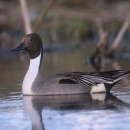Seasons of Wildlife
January
Geese, swans and ducks are present in the marsh along with hawks, great blue herons, and a few species of shorebirds. Mid-winter observations are best during thaws. Eagles, both bald and golden, are sometimes conspicuous along the Wildlife Drive. Resident bald eagles and great horned owls lay and incubate eggs.
February
First northward bound migrants appear late in February - killdeer, robins, and bluebirds. New eaglets hatch. Wintering waterfowl are preparing for the long flight north through intense foraging.
March
Most migratory waterfowl depart for points north. Masses of red-winged blackbirds pass through; some remain to nest. Osprey return from southern wintering grounds and begin constructing nests.
April
Resident ducks and geese are incubating eggs. The majority of migrant marsh birds return by mid-April. Blue-winged and green-winged teal passing through. (Blue-winged are latest in spring and earliest in fall). Delmarva fox squirrels are born. Young bald eaglets begin hatching (although some eagles have been known to nest early, and hatch their eaglets by the end of February). Osprey, wild turkey, and northern bobwhite all begin to nest. Late April and early May heralds peak shorebird migrations.
May
Migratory songbirds peak in late April and early May with warblers being most conspicuous and abundant. White-tail fawns (usually twins) begin to appear. Eaglets start to fledge; this will occur from the end of the month through the middle of June. The first broods of waterfowl appear.
June
Ospreys hatching in June. Eaglets learn how to fly and forage. Songbirds begin to nest.
July
Local goslings start to fly. Large quantities of insects are being consumed by swallows, kingbirds, and flycatchers. The conspicuous marsh hibiscus (mallow) begins to bloom along marsh edges at the end of month. Osprey young leave the nest.
August
Wading bird numbers increase. Blue-winged teal from the north arrive on southward migration. Some bald eagles disperse northward after the breeding season. Note: In the summer be prepared for large concentrations of flies and mosquitoes in the marshes and woods.
September
Ospreys migrate to South and Central America. Waterfowl numbers gradually increase. Egrets and herons accumulate until cold weather pushes them south. Tickseed sunflowers bloom; cattails go to seed. Songbird migration peaks in late September and early October. Toads are abundant.
October - December
Autumn colors peak. Blackbirds, the last of the songbird migrants, peak in October and November. Abundance of ducks and geese gradually increases, depending upon temperatures further north. Some remain all winter, others move south or disperse throughout the Delmarva Peninsula. Prescribed burning of the marsh begins for regeneration of specific waterfowl food resources. Tundra swans from Northwest Canada usually arrive in early November. Several hundred remain throughout the winter. White-tailed and sika deer breed from October to December. Bald eagle numbers increase with the arrival of migrants from the north. Resident bald eagles begin working on their nests high in loblolly pine trees. Golden eagles are occasionally seen during winter.
Featured Species
Blackwater National Wildlife Refuge is home to an incredible amount of plant and animal diversity in its three major habitats – forest, marsh and shallow water. The refuge contains one-third of Maryland's tidal wetlands, which makes it an ecologically important area within the state. It serves as an important resting and feeding area for migrating and wintering waterfowl, and is one of the chief wintering areas for Canada geese using the Atlantic Flyway. Blackwater NWR is home to the largest natural population of formerly endangered Delmarva peninsula fox squirrels and is also home to the largest breeding population of American bald eagles on the East Coast, north of Florida.









